With the snow starting to fall across the alps, Alice Payne explores Piedmont’s Vialattea region, as it opens up for the season…
Just an hour’s drive west from Turin is the romantically named ski region of Vialattea – Italian for ‘Milky Way,’ after the constellation of resorts that make up the area.
Leaning on my ski poles as I gaze across its alpine terrain, the scene is enticing. Wide slopes glisten with snow. Against the horizon, a frieze of white-peaked mountains stands in relief against an immaculate blue sky, while all around me, brightly-clothed skiers are careering down the piste like tropical skittles.
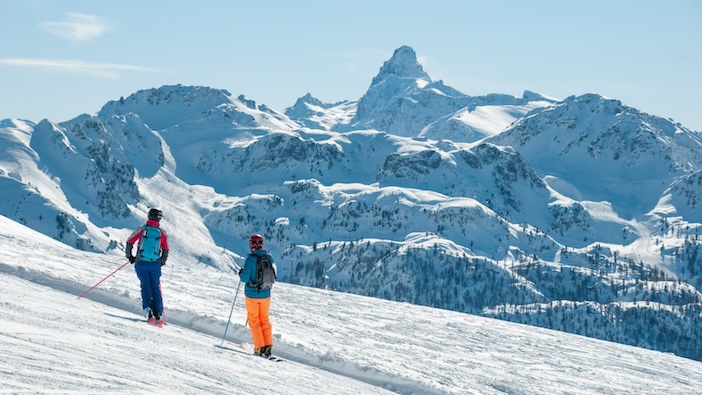
In contrast, I’m deliberating between pizza and spaghetti – but although it’s lunchtime, my choices aren’t culinary. Instead, I’m following the commands of Italian parents teaching their children to ski. True to type, the snow plough is a ‘pizza’ here, while instructions to ski parallel are delivered via shouts of ‘spaghetti!’ Somewhat out of my depth on a red slope and not wanting to end up as bolognese, I’m paying close attention.
It’s hard not to be distracted by the views, though. Softly sweeping pistes wind down to the village in one direction. In another, powdered mountain peaks unfold into the distance like cresting waves.
As one of the largest ski areas in Europe, Vialattea offers an expansive 250 trails to choose from, stretching 400 kilometres. It’s made up of eight resorts – seven in Italy’s Piedmont region and one in France’s Montgenèvre. With the Vialattea ski pass, it’s possible (for those who’ve graduated beyond pizzas and spaghettis) to ski across all eight in one day.
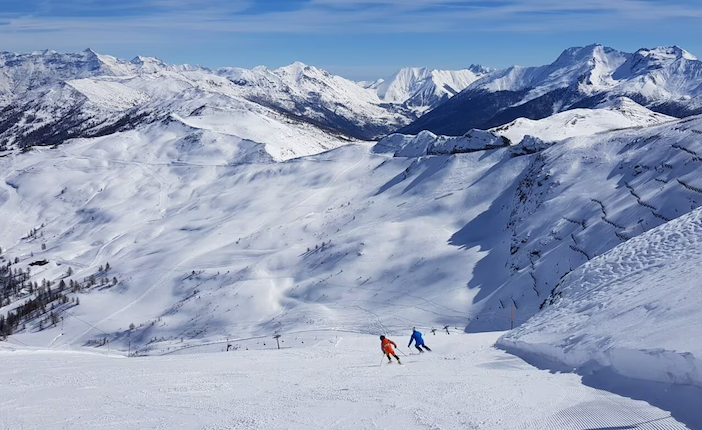
In fact, Vialattea is a haven for intermediate and advanced skiers, having hosted both the 1997 Alpine Ski World Championships and the 2006 Turin Winter Olympics – attested to by the more challenging slopes on offer. For those of us who prefer less hair-raising descents, there are a range of blue slopes too. The region has recently undergone extensive upgrades, from snow generators to ticket points and smart gates to make the experience more seamless.
Beyond the well-known pleasures of Piedmontese cuisine, what makes this region special is the unique character of each resort, offering a variety of holidays. There’s the alpine village of Sansicario, for instance, nicknamed ‘the sun terrace’ because of its location on a small plateau. Then there’s Claviere, which is popular with families due to its slope-side chalets and gentle blue runs.
At 2,035 metres, Sestriere is the region’s busiest destination and where the international skiing competitions take place. As I ski towards it along broad, powdery slopes, passing World Cup tracks and Olympic jumps, Sestriere appears strikingly different to the region’s other resorts, which formed organically from existing hamlets.
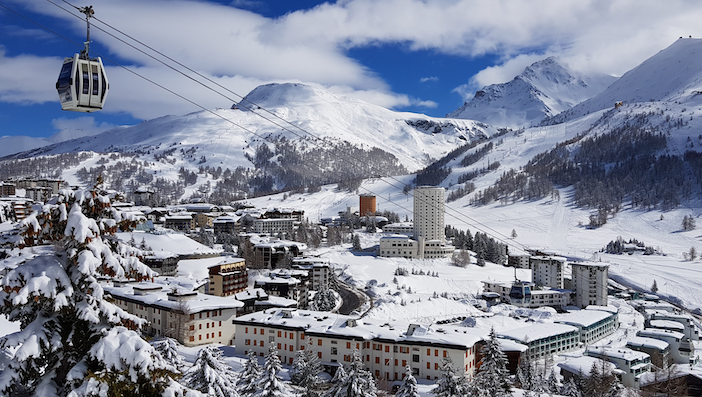
Instead, Sestriere is Italy’s first purpose-built ski resort, created at the behest of Gianni Agnelli in 1931, who spotted its location potential. Amongst the village’s low-rise apartments, two iconic round towers rise up. They were built by Agnelli in the 1930s as holiday retreats for his Fiat factory workers in Turin. Now hotels, they remain proud symbols of the village. The subtle architecture that’s followed is an attractive blend of wood, white and cream, complementing the tree-scattered mountains behind.
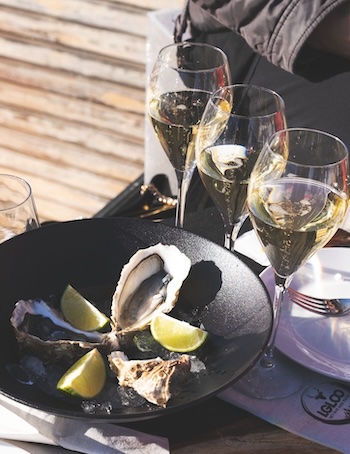 After a long day’s skiing, I’m happy to decant myself into one of the clear, heated domes at i.gloo bar at the base of Sestriere’s slopes – a great spot to enjoy an Aperol Spritz and watch the sun turn the mountains pink while the last of the day’s skiers wind their way home. As expected in Piedmont, the snacks are effortlessly sophisticated, with local delicacies like flavourful shortcrust cones of raw veal sausage.
After a long day’s skiing, I’m happy to decant myself into one of the clear, heated domes at i.gloo bar at the base of Sestriere’s slopes – a great spot to enjoy an Aperol Spritz and watch the sun turn the mountains pink while the last of the day’s skiers wind their way home. As expected in Piedmont, the snacks are effortlessly sophisticated, with local delicacies like flavourful shortcrust cones of raw veal sausage.
There is a more energetic apres-ski option in Sestriere, however, which is husky dog sledding. As we arrive one afternoon to take our slots, the dogs are cooling off in the snow after their last run. Within minutes, their barks become increasingly cacophonous and it’s clear they’re desperate to get going again. More strenuous than skiing, dog sledding is not for the faint-hearted, but it’s an exhilarating way to take in the scenery, working in tandem with a team of dogs whose greatest pleasure is racing through the snow at the speed of light.
Back in the village of Sauze d’Oulx, where I’m staying, there are numerous restaurants to choose from, but as night falls I’m whizzed back up the mountain on a snowmobile that makes the dog sledding seem sedate. When not on skis, it’s the only way to reach Ciao Pais, a popular restaurant that was once the last hut Italian soldiers passed before crossing into France during the second world war – hence its meaning, ‘Bye Country’.
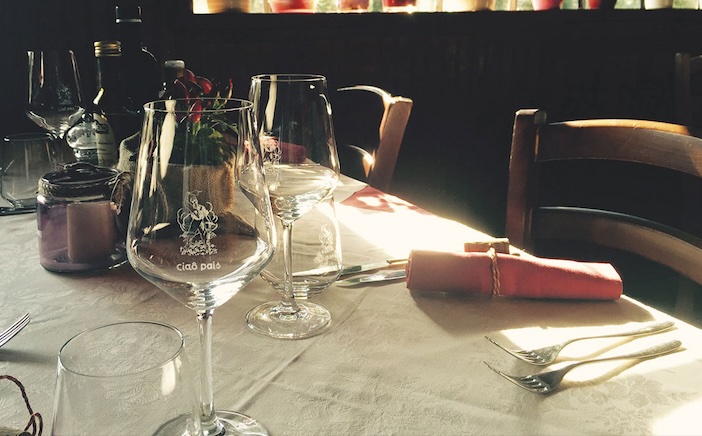
Within this warm alpine enclave, I’m brought dish after dish of exceptional regional specialities, from cured meats with blueberry jam to peppers stuffed with cheese and anchovies, a carpaccio trio of duck, goat and wild boar, a rich porcini and vegetable stew, truffle spaghetti and wild boar pasta.
This trip is my first experience of skiing in Italy and I was slightly concerned meals would be a rotation of margheritas. Thankfully, the only pizzas I encounter are my own amateur descents. The next day, exploring the slopes of Sauze d’Oulx, the terrain is noticeably different to Sestriere, with narrower, tree-lined trails and beautiful mountain views. These are best enjoyed over lunch at La Marmotta, a restaurant befitting a Bond film, sleekly designed in stone and wood with floor-to-ceiling glass windows and excellent cuisine.
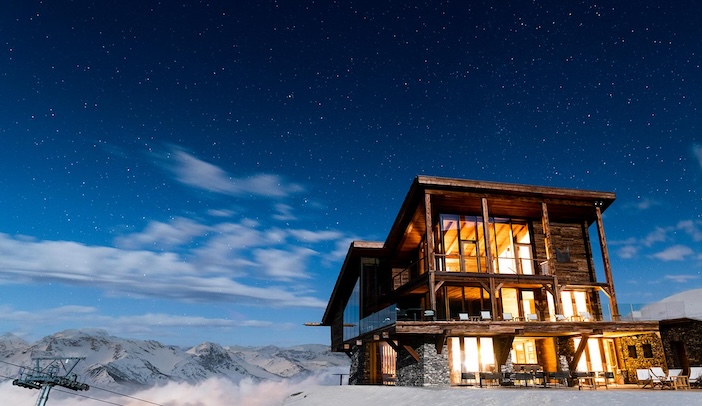
Dining in Vialattea is as much of a lure as the skiing and I enjoy an outstanding raclette with locally-produced vegetables and wine at Assietta in Sauze d’Oulx, followed by an equally impressive lunch the next day at nearby Il Farole.
After bidding goodbye to the cosy Hotel Chalet Faure, my last hours are spent exploring Sauze d’Oulx by foot. The old town’s medieval roots have been carefully preserved and the narrow, cobbled streets and courtyards – and occasional cattle fountains – all add to its charm. Located on the ancient pilgrim route to Jerusalem, the formerly French village was handed to Italy in the 18th century and in more recent years became popular with British visitors, a number of whom never left.
Sauze d’Oulx has a fitting nickname: ‘the balcony of the Alps.’ On this quiet, sunny morning, I find myself sitting on a terrace behind an old church, overlooking the valley with uninterrupted mountain views. The tranquil scene feels ageless as smoke curls out of a distant chimney, birds dart and sing, and snow-laden trees wait patiently for Spring. Soaking it all in, I can’t think of a better balcony from which to enjoy the Alps.
You can find more information about visiting Vialattea at www.vialattea.it. Ryan Air offers regular flights from London Stansted to Turin Caselle.
Photos courtesy of Vialattea Tourism




